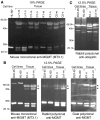Expression of O6-Methylguanine-DNA Methyltransferase Examined by Alkyl-Transfer Assays, Methylation-Specific PCR and Western Blots in Tumors and Matched Normal Tissue
- PMID: 23946891
- PMCID: PMC3740405
- DOI: 10.4236/jct.2013.44103
Expression of O6-Methylguanine-DNA Methyltransferase Examined by Alkyl-Transfer Assays, Methylation-Specific PCR and Western Blots in Tumors and Matched Normal Tissue
Abstract
The tumor selectivity of alkylating agents that produce guanine O6-chloroethyl (laromustine and carmustine) and O6-methyl (temozolomide) lesions, depends upon O6-methylguanine-DNA methyltransferase (MGMT) activity being lower in tumor than in host tissue. Despite the established role of MGMT as a tumor resistance factor, consensus on how to assess MGMT expression in clinical samples is unsettled. The aim of this study is to examine the relationship between the values derived from distinctive MGMT measurements in 13, 12, 6 and 2 pairs of human tumors and matched normal adjacent tissue from the colon, kidney, lung and liver, respectively, and in human cell lines. The MGMT measurements included (a) alkyl-transfer assays using [benzene-3H]O6-benzylguanine as a substrate to assess functional MGMT activity, (b) methylation-specific PCR (MSP) to probe MGMT gene promoter CpG methylations as a measure of gene silencing, and (c) western immunoblots to analyze the MGMT protein. In human cell lines, a strict negative correlation existed between MGMT activity and the extent of promoter methylation. In tissue specimens, by contrast, the correlation between these two variables was low. Moreover, alkyl-transfer assays identified 3 pairs of tumors and normal tissue with tumor-selective reduction in MGMT activity in the absence of promoter methylation. Cell line MGMT migrated as a single band in western analyses, whereas tissue MGMT was heterogeneous around its molecular size and at much higher molecular masses, indicative of multi-layered post-translational modifications. Malignancy is occasionally associated with a mobility shift in MGMT. Contrary to the prevalent expectation that MGMT expression is governed at the level of gene silencing, these data suggest that other mechanisms that can lead to tumor-selective reduction in MGMT activity exist in human tissue.
Keywords: Laromustine (Onrigin, Cloretazine, VNP40101M, 101M); Methylation-Specific PCR (MSP); O6-Methylguanine-DNA Methyltransferase (MGMT, O6-Alkylguanine-DNA Alkyltransferase, AGT); Temozolomide; [Benzene-3H]O6-Benzylguanine.
Figures






References
-
- Christmann M, Verbeek B, Roos WP, Kaina B. O6-Methylguanine-DNA Methyltransferase (MGMT) in Normal Tissues and Tumors: Enzyme Activity, Promoter Methylation and Immunohistochemistry. Biochimica et Biophysica Acta. 2011;Vol. 1816(No. 2):179–190. - PubMed
-
- Kaina B, Christmann M, Naumann S, Roos WP. MGMT: Key Node in the Battle against Genotoxicity, Carcinogenicity and Apoptosis Induced by Alkylating Agents. DNA Repair. 2007;Vol. 6(No. 8):1079–1099. - PubMed
-
- Gerson SL. MGMT: Its Role in Cancer Aetiology and Cancer Therapeutics. Nature Reviews Cancer. 2004;Vol. 4(No. 4):296–307. - PubMed
Grants and funding
LinkOut - more resources
Full Text Sources
Other Literature Sources
Research Materials
Miscellaneous
